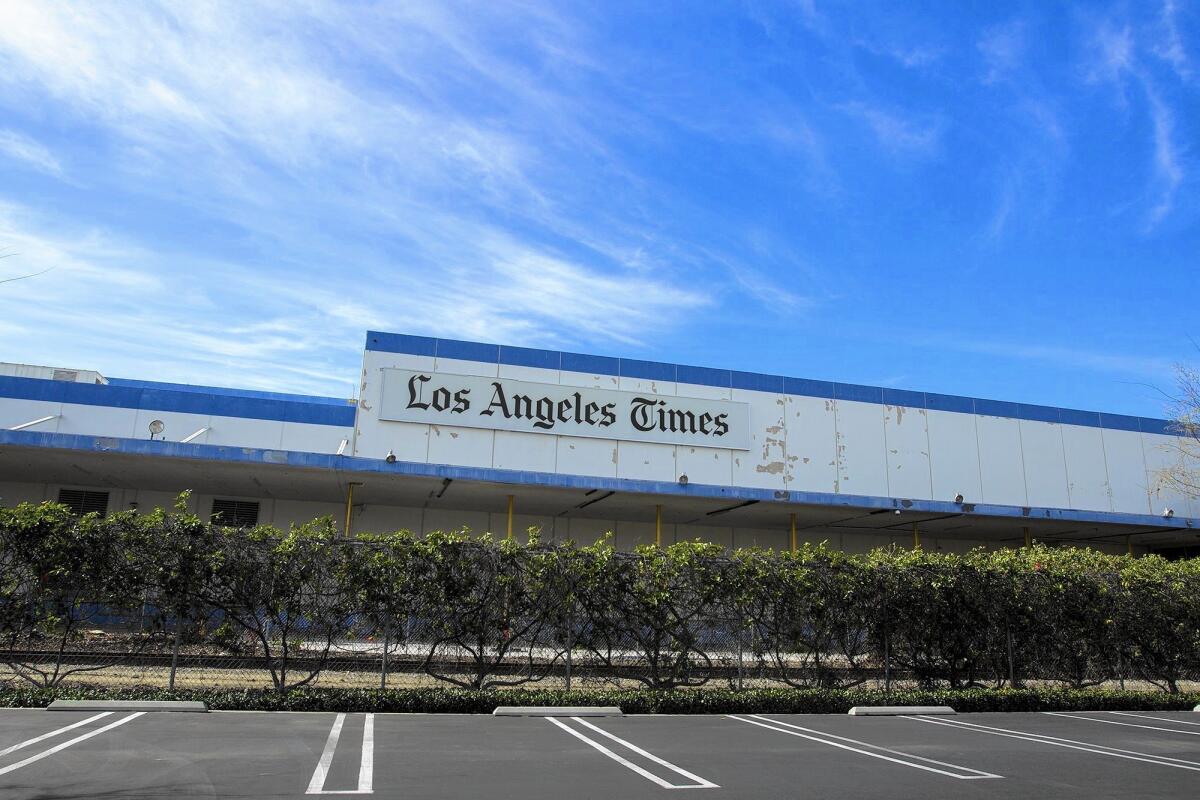Former Times plant in Costa Mesa subject to hipster nostalgia? Sounds like it
- Share via
It’s been 19 years since I moved to Newport Beach.
Back then I was a young — OK, younger — reporter with two kids and a husband who was losing his mind driving the 405 Freeway every day between our home in Los Angeles and his business in Orange County. There was an opening in the Los Angeles Times’ Orange County edition, and I grabbed the chance for a transfer south.
We decided that we wanted to live within the boundaries of Newport-Mesa Unified School District. We stretched our budget to buy a house in Newport Beach. At the time I thought it would be a brief interlude until our next move.
You can see how that turned out.
Many years have passed since I left my full-time reporting gig. I gave up the job of my dreams because I thought that my sons would benefit from more of my undivided time and attention. It was one of the toughest decisions I ever made, and not a day goes by that I don’t miss the daily grind.
No regrets, though. I’m a fortunate woman to have had the luxury to make such a choice, and I’ve led what by any measure can only be described as a charmed life here in Orange County.
Meanwhile, my love of news endures even as the newspaper business, buffeted by the winds of our Internet-driven age, continues to shrink and many of the places where old-school journalists and pressmen once plied their trade become relics of times passed.
Now I hear that the building where I used to work, the former Times plant in Costa Mesa on Sunflower Avenue — also once home to the Daily Pilot — is slated to be repurposed into one of those trendy, open office space facilities that are supposed to inspire creativity and innovation. In an homage to its ink-stained heritage, it will be called The Press and will feature volleyball courts, grills and outdoor seating, because, we are meant to believe, such amenities inspire workers to change the world for the better.
And that just makes me sad. Or laugh. Sad laugh.

The plan is to sell tenants on the ambience of the building’s origins, although my erstwhile colleagues would no doubt snicker at my use of the term “ambience” in connection with our charmless former digs. As much as I loved my old job, the structure itself is little more than a big box where giant presses once droned on one side and, on the other end, reporters and editors were stuffed into a honeycomb of drab cubicles adorned with varying levels of clutter.
“We’re going to play off that history, that authenticity of the building. All that stuff makes it cool,” said one of the developers to The Times last month.
While it’s not a bad idea to recycle this rather characterless monument to print journalism, I can’t help but cringe at the thought of empty newsrooms now apparently of value only due to hipster nostalgia.
If I sound a bit bitter, so be it. But to me, that building stands as a symbol of loss, because no matter how much deference is paid to its heritage, it’s what used to happen inside that made it great. And now that’s all gone.
The slow and agonizing decline of print journalism is creating a void that, so far, no one has quite figured out how to replace. Newspapers, even in their vastly diminished state, are still the places where real journalism happens, where writers and editors adhere to time-honored principles of researching, fact-checking and digging deep to uncover information, insights and vivid details that are presented in thoughtful, well-written articles.
Consider the Academy Award-winning movie “Spotlight,” which tells the true story of a team of investigative journalists at the Boston Globe who broke new ground on the Catholic Church’s cover-up of pedophile priests. The most accurate depiction of newspaper work that I’ve ever seen, the film nails the painstaking, oftentimes tedious work and difficulty that goes into producing quality news reports.
That kind of depth and diligence is a far cry from the Twitter feeds and video sound bites that dominate our news cycle today. Indeed, “Spotlight”-style investigations are becoming far less common as news organizations run up against plummeting advertising revenue and readership.
According to a Brookings Institution report, the number of newspaper journalists dropped 39% from 1989 to 2012. They’ll likely never come back.
This is something we should all care about. As newspapers across the country close down or limp along in diminished states, our democracy suffers too. A dearth of reliable journalism can only mean that corruption will go uncovered, power will remain unchecked and substantive stories won’t be told.
I drove past the old plant recently. It looked much the same, except that the big Los Angeles Times sign has been replaced with new signage for ThePressOC.com.
I checked out the website for the project. Artistic renderings for it depict a modern, airy workspace.
It actually looks pretty decent.
It promises “a space not only worthy of how far you’ve come, but designed to take your creative culture and your business to the next level. A space where a storied past serves as the backdrop for an awe-inspiring future.”
It invites prospective tenants “to treat tomorrow as a chance to outshine yesterday.”
If only.
---
PATRICE APODACA is a former Newport-Mesa public school parent and former Los Angeles Times staff writer. She lives in Newport Beach.
